Search results for: 'testing'
-
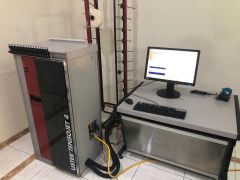 TT-3305 USTER TENSOJET 4 SINGLE YARN STRENGTH TESTER, YEAR 2014TT-3305 USTER TENSOJET 4 SINGLE YARN STRENGTH TESTER, YEAR 2014 QUANTITY: 1 Learn More
TT-3305 USTER TENSOJET 4 SINGLE YARN STRENGTH TESTER, YEAR 2014TT-3305 USTER TENSOJET 4 SINGLE YARN STRENGTH TESTER, YEAR 2014 QUANTITY: 1 Learn More -
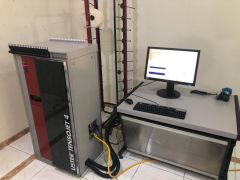 TT-2100 USTER TENSOJET 4 SINGLE YARN STRENGTH TESTER, YEAR 2014TT-2100 USTER TENSOJET 4 SINGLE YARN STRENGTH TESTER, YEAR 2014 QUANTITY: 1 Learn More
TT-2100 USTER TENSOJET 4 SINGLE YARN STRENGTH TESTER, YEAR 2014TT-2100 USTER TENSOJET 4 SINGLE YARN STRENGTH TESTER, YEAR 2014 QUANTITY: 1 Learn More -
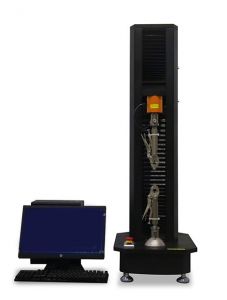 TT-1037 SINGLE COLUMN TENSILE STRENGTH TESTERTT-1037 SINGLE COLUMN TENSILE STRENGTH TESTER KEY SPECIFICATIONS CAPACITY: 50N, 100N, 200N, 500N, 1KN, 2KN, 2.5KN, 5KN DISPLAY: COMPUTER DISPLAY FORCE RESOLUTION: 1/100,000 FORCE ACCURACY: ≤+/-0.5% STROKE RANGE: 1000mm STROKE RESOLUTION: 0.001mm TEST SPEED: 0.001-1000mm/MIN CAN SET ON DISPLAY, WITH UP & DOWN FAST ADJUSTMENT BUTTON OF GRIPS FORCE UNIT SWITCH: KGF, N, IBF, G, TON, MPA STOP MODE: OVERLOAD STOP, EMERGENCY STOP BUTTON. SPECIMEN DAMAGE AUTOMATIC STOP MACHINE DRIVE: SERVO MOTOR DRIVE, SYNCHRONOUS WHEEL AND PRECISION BALL SCREW DRIVE POWER: 120W POWER SUPPLY: AC 220V 50-60Hz 10A DIMENSIONS: APPROX 500 X 400 X 1450mm WEIGHT: 60KG ACCESSORIES: STANDARDS ACCESSORIES: 1 SET MANUAL GRIPS, 1 PC LOAD CELL, 1 PC ENGLISH OPERATION SOFTWARE, 1 PC CABLE CONNECT WITH PC OPTION ACCESSORIES: OPTIONAL DESKTOP COMPUTER OPTIONAL OTHER GRIPS QUANTITY: 1 Learn More
TT-1037 SINGLE COLUMN TENSILE STRENGTH TESTERTT-1037 SINGLE COLUMN TENSILE STRENGTH TESTER KEY SPECIFICATIONS CAPACITY: 50N, 100N, 200N, 500N, 1KN, 2KN, 2.5KN, 5KN DISPLAY: COMPUTER DISPLAY FORCE RESOLUTION: 1/100,000 FORCE ACCURACY: ≤+/-0.5% STROKE RANGE: 1000mm STROKE RESOLUTION: 0.001mm TEST SPEED: 0.001-1000mm/MIN CAN SET ON DISPLAY, WITH UP & DOWN FAST ADJUSTMENT BUTTON OF GRIPS FORCE UNIT SWITCH: KGF, N, IBF, G, TON, MPA STOP MODE: OVERLOAD STOP, EMERGENCY STOP BUTTON. SPECIMEN DAMAGE AUTOMATIC STOP MACHINE DRIVE: SERVO MOTOR DRIVE, SYNCHRONOUS WHEEL AND PRECISION BALL SCREW DRIVE POWER: 120W POWER SUPPLY: AC 220V 50-60Hz 10A DIMENSIONS: APPROX 500 X 400 X 1450mm WEIGHT: 60KG ACCESSORIES: STANDARDS ACCESSORIES: 1 SET MANUAL GRIPS, 1 PC LOAD CELL, 1 PC ENGLISH OPERATION SOFTWARE, 1 PC CABLE CONNECT WITH PC OPTION ACCESSORIES: OPTIONAL DESKTOP COMPUTER OPTIONAL OTHER GRIPS QUANTITY: 1 Learn More -
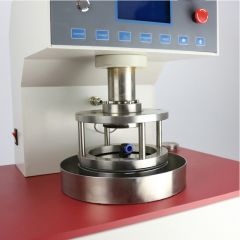 T-9595 DIGITAL HYDROSTATIC HEAD TESTERT-9595 DIGITAL HYDROSTATIC HEAD TESTER KEY SPECIFICATION TESTING RANGE: 500PA-200KPA WATER PRESSURE INCREASE RATE: 1KPA-30KPA ACCURACY: 0.2 % F.S SPECIMEN TEST AREA: 1000mm2, OR 78mm2 (OPTION) TESTING MODE 1) P. RISE 2) CONST P & TIMING 3) CONST P & TIME 4) WATER PENETRATION 5) FATIGUE TESTING UNIT: PA, MMHG, CMH2O POWER SUPPLY: AC 220V 50/60Hz DIMENSION: 600 X 450 X 640mm (L X W X H) WEIGHT: 60 KG Learn More
T-9595 DIGITAL HYDROSTATIC HEAD TESTERT-9595 DIGITAL HYDROSTATIC HEAD TESTER KEY SPECIFICATION TESTING RANGE: 500PA-200KPA WATER PRESSURE INCREASE RATE: 1KPA-30KPA ACCURACY: 0.2 % F.S SPECIMEN TEST AREA: 1000mm2, OR 78mm2 (OPTION) TESTING MODE 1) P. RISE 2) CONST P & TIMING 3) CONST P & TIME 4) WATER PENETRATION 5) FATIGUE TESTING UNIT: PA, MMHG, CMH2O POWER SUPPLY: AC 220V 50/60Hz DIMENSION: 600 X 450 X 640mm (L X W X H) WEIGHT: 60 KG Learn More -
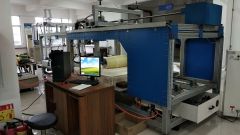 L-7136 MATTRESS DURABILITY COMPREHENSIVE TESTER
L-7136 MATTRESS DURABILITY COMPREHENSIVE TESTERABLE TO DO ROLLING TESTS ON MATTRESSES
DURABILITY TEST FOR THE BED SURFACE:
1. USES INDEPENDENT CONTROL SYSTEM. PLC CONTROL SEPARATELY. COOPERATE WITH COLOR TOUCH SCREEN. IT IS
CONVENIENT AND VISUAL TO OPERATE. THE TESTING PROCESS AND THE RUNNING STATUS BE CLEAR TO US, TEST TIMES CAN
BE SET FREELY.
2. SPECIAL LIFT DEVICE IS CONVENIENT TO LIFT UP THE HEAVY ROLLER AND EASY TO MOVE IT TO THE TEST AREA OF THE
MATTRESS. THEN PUT DOWN THE ROLLER AND MAKE ITS OWN WEIGHT FULLY LOAD TO THE SURFACE OF THE MATTRESS.
3.ROLLER CAN MOVE UP AND DOWN IN THE TESTING PROCESS, TO ADAPT TO CONCAVE AND CONVEX SURFACE OF THE
MATTRESS.
4. WHEN DOING DURABILITY TEST OF EDGE, ROLLER CAN BE MOVED TO THE “PARKING” AREA BEHIND THE INSTRUMENT.
5. DURABILITY TEST FOR THE EDGE IS DRIVEN BY SERVO MOTOR; IT IS QUIET, STEADY AND RELIABLE TO OPERATE.
6. INCORPORATES ADVANCED PHOTOELECTRIC SENSE TECHNOLOGY. THE BEGINNING POSITION OF THE CENTER LINE OF THE
CUSHION SURFACE RETURN TO THE HOME POSITION AUTOMATICALLY.
DURABILITY TEST FOR BED EDGE :
ADOPT INDEPENDENT CONTROL SYSTEM, USING DEDICATED HIGH-PRECISION AND HIGH INTELLIGENT ARAM CONTROLLER
AND SPECIAL TEST SOFTWARE. IT CAN RUN UNDER WINDOWS SYSTEM ON PC, IT IS OPERATED ALL BY SOFTWARE, THE
INTERFACE OF SOFTWARE IS EASY TO OPERATE.
SPECIAL TEST SOFTWARE ON PC, WINDOWS OPERATING PAGE, A HIGH DEGREE OF COMPATIBILITY.
TEST PROGRAM HAS ALREADY BEEN SET ON THE SOFTWARE ON PC ACCORDING TO THE TEST REQUIREMENT. A KEY TO TEST.
IT IS CONVENIENT FOR OPERATOR TO LEARN AND SAVE THE TRAINING TIME.
THE CURVE WINDOW OF TEST SOFTWARE DISPLAY THE VALUES OF FORCE AND SHIFT IN REAL TIME, COORDINATE MODEL.
LOADING CUSHION ON THE EDGE AND LOADING CUSHION WHICH IS USED FOR MEASURING USE GENERIC CONNECTION
HEAD THAT CAN BE IN INTERCHANGED. SHARING A SET OF DRIVING DEVICE, SAVE SPACE AND COST.
ADJUSTABLE RACK. THE PRESSURE PLATE CAN BE ADJUSTED THE POSITION ALONG THE DIRECTION OF X AND Y. IT CAN
MEASURE EACH POINT OF THE MATTRESS. IT IS DIFFERENT FROM THE TRADITION WAY TO SEPARATE. THE TEST CAN BE
FINISHED WITHOUT MOVING THE SAMPLE.
SAVE A LOT OF TESTING TIME, GREATLY REDUCES THE WORKING INTENSITY, OPERATORS CAN ACHIEVE SINGLE OPERATION,
SAVE THE COMPANY COST.
FORCE SENSOR AVOIDS DAMAGE TO THE CORE COMPONENTS BECAUSE IT CAN MAKE PROTECTION WHEN IT IS OVERLOAD.ROLLING TEST SPEED: 16±2CYCLES PER MINUTE (OR SPECIFIED BY CUSTOMER)
Learn More
CYLINDER ROLLER: 1400N, THE MIDDLE DIAMETER: 300mm, BOTH ENDS DIAMETER: 250mm, LENGTH: 1000
HEXAGON STYLE WOODEN ROLLER: SIZE AS STANDARD REQUIREMENT
COUNTER: 0~999999 CAN BE SET.
THE CONTROL WAY OF ROLLING: TOUCH SCREEN + PLC CONTROL
LOADING CUSHION ON THE EDGE: BUTTOCKS SHAPE, 380mm X 495mm
LOADING PARTS ON THE EDGE: THE MIDPOINT ON THE LONG EDGE OF THE MATTRESS.200 mm FROM EDGE.
LOADING FORCE ON THE EDGE: 1000N
LOADING TIME ON THE EDGE: 3S
POSITION OF MEASUREMENT: MATTRESS CENTER, LEFT AND RIGHT ARE BOTH 250mm, THE MIDPOINT ON THE LONG EDGE
OF THE MATTRESS 200 mm INWARD.
LOADING PLATE OF MEASUREMENT: DIAMETER 355mm, RADIUS OF CURVATURE OF THE END R800mm
CAPACITY OF FORCE SENSOR: 2KN
LOADING SPEED OF MEASUREMENT: 90±5mm/MIN
STROKE: 500mm
DRIVE MOTOR: SERVO MOTOR -
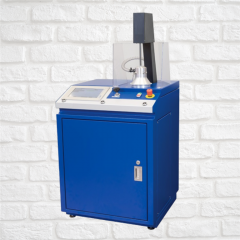 D-2380 AUTOMATED FILTER TESTER
D-2380 AUTOMATED FILTER TESTERTHE AUTOMATED FILTER TESTER MODEL 9981 CONTINUES TO BE THE BEST SOLUTION FOR TESTING PARTICULATE RESPIRATOR FILTERS, DISPOSABLE FILTERING FACE PIECES, AND A WIDE ASSORTMENT OF FILTER MEDIA. OUR FILTER TESTERS HAVE BEEN USED IN QUALITY CONTROL AND MANUFACTURING BY LEADING FILTER AND FILTER MEDIA MANUFACTURERS AND REFERENCE TEST INSTITUTES AROUND THE WORLD FOR MORE THAN 20 YEARS DUE TO THEIR PROVEN DURABILITY AND RELIABILITY, WHICH IS VALUED IN DEMANDING MANUFACTURING ENVIRONMENTS AND QA/QC LABORATORIES.
THIS MODEL OFFERS HIGHER SENSITIVITY AND RESOLUTION THAN PREVIOUS MODELS - UP TO 99.9999 PERCENT EFFICIENCY HAS BEEN PRODUCED WITH EMERY OIL AT CONCENTRATIONS OF 200 MG/M³. THE NEW SERVICEABLE PHOTOMETERS ARE LOWERING THE COST OF OWNERSHIP AND ENABLE PROACTIVE SCHEDULING OF MAINTENANCE FOR MINIMAL IMPACT TO PRODUCTION SCHEDULES.
THE MODEL 9981 FEATURES A HIGH DEGREE OF AUTOMATION AND SELF-DIAGNOSTICS THAT GREATLY SIMPLIFIES OPERATION, INCREASES THROUGHPUT, AND IMPROVES OVERALL MEASUREMENT PERFORMANCE. WHEN LOOKING FOR A STAND-ALONE TESTER TO DETERMINE PENETRATION OR FILTER EFFICIENCY AND PRESSURE DROP OF YOUR MEDIA, FILTER CARTRIDGES, FILTERS, AND RESPIRATORY MASKS THE MODEL 9981 IS UP TO THE CHALLENGE.
THE BUILT-IN CAPABILITY TO TEST WITH SALT AND OIL MEANS THAT JUST ONE UNIT IS NEEDED TO TEST YOUR PRODUCT TO:
• US 42 CFR 84, GB2626, JMOL
• ISO 16900-3, EN 143
• ISO 23328-1 (AND MORE)
APPLICATIONS
• USA COMMERCIAL RESPIRATOR REGULATION 42 CFR PART 84
• CHINESE RESPIRATOR STANDARD GB2626
• JAPANESE RESPIRATOR STANDARD JMOL
• EUROPEAN EN 143, ISO 16900-3 AND RELATED RESPIRATOR STANDARDS
• ISO 23328-1 (TESTING FILTERS FOR ANAESTHETIC USE)
• FILTER MEDIA TESTING
• CONSULT OUR REPRESENTATIVE FOR MORE DETAILS
INCLUDED ITEMS
• REFERENCE MEDIA SHEETS
• FLAT-MEDIA AND GRAVIMETRIC FILTER HOLDER
• REFERENCE PRESSURE DROP PLATE
• OIL AND SALT AEROSOL GENERATORS
• SELECTED SPARE PARTS
• CONTACT US FOR CUSTOM FILTER HOLDERSEMAIL US FOR PRICE & PICTURES
Learn More
INCLUDE OUR REFERENCE NUMBER -
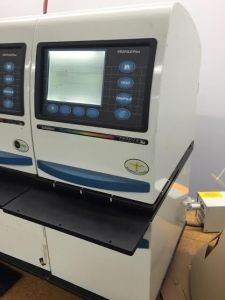 L-2176 PROFILE PLUS ROUGHNESS AND POROSITY MACHINE
L-2176 PROFILE PLUS ROUGHNESS AND POROSITY MACHINELIST NUMBER: L-2176
Learn More
PROFILE PLUS ROUGHNESS AND POROSITY MACHINE
WEIGHT: 37 KGS
HEIGHT: 660mm
DEPTH: 460mm
WIDTH: 267mm
QUANTITY: 1 -
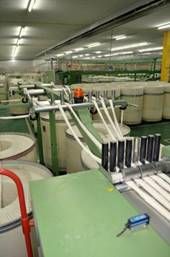 C-2876 RIETER SPINNING MACHINES, LABORATORY, DRAWING, COMBING, & CARDING, YEAR 2001
C-2876 RIETER SPINNING MACHINES, LABORATORY, DRAWING, COMBING, & CARDING, YEAR 2001REFERENCE NUMBER: C-2876
RIETER SPINNING MACHINES, LABORATORY, DRAWING, COMBING, & CARDING, YEAR 2001
DETAILS:
OFFER 001
TOYODA SIMPLEX ACCESSORIES
SIMPLEX ACCESSORIES
TOYODA
YEAR: 2001
QUANTITY: 1
OFFER 002
USTER LABORATORY UT3
LABORATORY
USTER
MODEL: UT3
TYPE: YARN TESTING
YEAR: 2001
QUANTITY: 1 SET
OFFER 003
USTER LABORATORY AFIS
LABORATORY
USTER
MODEL: AFIS
TYPE: FIBER TESTING
YEAR: 2001
QUANTITY: 1
OFFER 004
USTER LABORATORY HVI
LABORATORY
USTER
MODEL: HVI
TYPE: FIBER TESTING
YEAR: 2001
QUANTITY: 1
OFFER 005
RIETER BLOW ROOM ACCESSORIES
BLOW ROOM ACCESSORIES
RIETER
TYPE: STAND ALONE
YEAR: 2001
QUANTITY: 1
OFFER 006
MINGCHENG BLOW ROOM ACCESSORIES
BLOW ROOM ACCESSORIES
MINGCHENG
TYPE: STAND ALONE
YEAR: 2001
QUANTITY: 2 SETS
OFFER 007
MINGCHENG BLOW ROOM ACCESSORIES
BLOW ROOM ACCESSORIES
MINGCHENG
TYPE: STAND ALONE
YEAR: 2001
QUANTITY: 2
OFFER 008
OTHERS STRENGTH TESTER LABORATORY
LABORATORY
OTHERS STRENGTH TESTER
TYPE: GENERAL
YEAR: 2001
QUANTITY: 1
OFFER 009
WELKER YARN CONDITIONING PLANT CONDIBOX
YARN CONDITIONING PLANT
WELKER
MODEL: CONDIBOX
YEAR: 2001
QUANTITY: 1
OFFER 010
MINGCHENG BLOW ROOM FLOCK FEEDER
BLOW ROOM
MINGCHENG
MODEL: FLOCK FEEDER
TYPE: AUTOMATIC BALE OPENER
YEAR: 2001
QUANTITY: 2
OFFER 011
MINGCHENG BLOW ROOM MPM
BLOW ROOM
MINGCHENG
MODEL: MPM
TYPE: MIXER
YEAR: 2001
QUANTITY: 2
OFFER 012
RIETER COMBER E75
COMBER
RIETER
MODEL: E75
YEAR: 2001
QUANTITY: 1
OFFER 013
RIETER COMBER E60
COMBER
RIETER
MODEL: E60
YEAR: 2001
QUANTITY: 1
OFFER 014
OTHERS DOGETECH BREAKER DRAWING WITHOUT AUTOLEVELLER DV2
BREAKER DRAWING WITHOUT AUTOLEVELLER
OTHERS DOGETECH
MODEL: DV2
YEAR: 2001
QUANTITY: 2
OFFER 015
OTHERS DOGETECH FINISHER DRAWING WITH AUTOLEVELLER DV2 AL
FINISHER DRAWING WITH AUTOLEVELLER
OTHERS DOGETECH
MODEL: DV2 AL
YEAR: 2001
QUANTITY: 3
OFFER 016
TOYODA SIMPLEX FL200
TOYODA
MODEL: FL200
YEAR: 2001
QUANTITY: 1
OFFER 017
RIETER FINISHER DRAWING WITH AUTOLEVELLER RSB D30
FINISHER DRAWING WITH AUTOLEVELLER
RIETER
MODEL: RSB D30
YEAR: 2001
QUANTITY: 2
OFFER 018
RIETER BREAKER DRAWING WITHOUT AUTOLEVELLER SB D10
BREAKER DRAWING WITHOUT AUTOLEVELLER
RIETER
MODEL: SB D10
YEAR: 2001
QUANTITY: 4
OFFER 019
RIETER CARDING C51
CARDING
RIETER
MODEL: C51
YEAR: 2001
QUANTITY: 15 SETS
OFFER 020
LOPTEX BLOW ROOM
BLOW ROOM
LOPTEX
TYPE: FOREIGN FIBER SEPARATOR
YEAR: 2001
QUANTITY: 1
OFFER 021
RIETER BLOW ROOM B60
BLOW ROOM
RIETER
MODEL: B60
TYPE: CLEANER WITH FEED TRUNK AND CONDENSOR (COTTON)
YEAR: 2001
QUANTITY: 2
OFFER 022
RIETER BLOW ROOM
BLOW ROOM
RIETER
TYPE: UNIMIX
YEAR: 2001
QUANTITY: 2
OFFER 023
RIETER BLOW ROOM B11
BLOW ROOM
RIETER
MODEL: B11
TYPE: PRE - CLEANER
YEAR: 2001
QUANTITY: 1
OFFER 024
RIETER BLOW ROOM B2/5
BLOW ROOM
RIETER
MODEL: B2/5
TYPE: WASTE OPENER
YEAR: 2001
QUANTITY: 1
OFFER 025
RIETER BLOW ROOM A11
BLOW ROOM
RIETER
MODEL: A11
TYPE: AUTOMATIC BALE OPENER
YEAR: 2001
QUANTITY: 1
OFFER 026
MINGCHENG CARDING
CARDING
MINGCHENG
YEAR: 2001
QUANTITY: 6
OFFER 027
MINGCHENG BLOW ROOM
BLOW ROOM
MINGCHENG
TYPE: AUTOMATIC BALE OPENER
YEAR: 2001
QUANTITY: 2
Learn More -
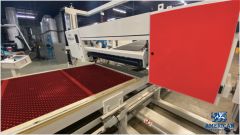 J-5148 EDGE SWEETS MODEL WHDS-54 MEDIUM DENSITY HORIZONTAL SKIVER, YEAR 2019, WORKING WIDTH 54”J-5148 EDGE SWEETS MODEL WHDS-54 MEDIUM DENSITY HORIZONTAL SKIVER, YEAR 2019, WORKING WIDTH 54” PRACTICALLY NEW – ONLY RUN 80 HOURS FOR TESTING ONLY, THEN THE PROJECT WAS CANCELLED. QUANTITY: 1 Learn More
J-5148 EDGE SWEETS MODEL WHDS-54 MEDIUM DENSITY HORIZONTAL SKIVER, YEAR 2019, WORKING WIDTH 54”J-5148 EDGE SWEETS MODEL WHDS-54 MEDIUM DENSITY HORIZONTAL SKIVER, YEAR 2019, WORKING WIDTH 54” PRACTICALLY NEW – ONLY RUN 80 HOURS FOR TESTING ONLY, THEN THE PROJECT WAS CANCELLED. QUANTITY: 1 Learn More -
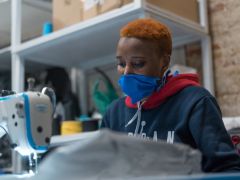 D-2388 What’s the Best Material for a Mask?
D-2388 What’s the Best Material for a Mask?Federal health officials have now recommended that we cover our faces with fabric during the coronavirus pandemic. But what material offers the most protection?
The Centers for Disease Control and Prevention has posted a no-sew mask pattern using a bandanna and a coffee filter as well as a video on making masks using rubber bands and folded fabrics found at home.
While a simple face covering can reduce the spread of coronavirus by blocking outgoing germs from coughs or sneezes of an infected person, experts say there is more variation in how much homemade masks might protect the wearer from incoming germs, depending on the fit and quality of the material used.
Scientists around the country have taken it upon themselves to identify everyday materials that do a better job of filtering microscopic particles. In recent tests, HEPA furnace filters scored well, as did vacuum cleaner bags, layers of 600-count pillowcases and fabric similar to flannel pajamas. Stacked coffee filters had medium scores. Scarves and bandanna material had the lowest scores, but still captured a small percentage of particles.
If you don’t have any of the materials that were tested, a simple light test can help you decide whether a fabric is a good candidate for a mask.
“Hold it up to a bright light,” said Dr. Scott Segal, chairman of anesthesiology at Wake Forest Baptist Health who recently studied homemade masks. “If light passes really easily through the fibers and you can almost see the fibers, it’s not a good fabric. If it’s a denser weave of thicker material and light doesn’t pass through it as much, that’s the material you want to use.”
Researchers say it’s important to remember that lab studies are conducted under perfect conditions with no leaks or gaps in the mask, but the test methods give us a way to compare materials. And while the degree of filtration for some homemade masks seems low, most of us — who are staying home and practicing social distancing in public — don’t need the high level of protection required for medical workers. More important, any face covering is better than none, especially if worn by a person who has the virus but doesn’t know it.
The biggest challenge of choosing a homemade mask material is to find a fabric that is dense enough to capture viral particles, but breathable enough that we can actually wear it. Some items being touted online promise high filtration scores, but the material would be unwearable.
Dressing Up for Work … at Home
Yang Wang, an assistant professor of environmental engineering at Missouri University of Science and Technology, worked with his graduate students to study various combinations of layered materials — including both air filters and fabric. “You need something that is efficient for removing particles, but you also need to breathe,” said Dr. Wang, who last fall won an international award for aerosol research.To test everyday materials, scientists are using methods similar to those used to test medical masks, which everybody agrees should be saved for medical workers who are exposed to high doses of virus from seeing infected patients. The best medical mask — called the N95 respirator — filters out at least 95 percent of particles as small as 0.3 microns. By comparison, a typical surgical mask — made using a rectangular piece of pleated fabric with elastic ear loops — has a filtration efficiency ranging from 60 to 80 percent.
Dr. Wang’s group tested two types of air filters. An allergy-reduction HVAC filter worked the best, capturing 89 percent of particles with one layer and 94 percent with two layers. A furnace filter captured 75 percent with two layers, but required six layers to achieve 95 percent. To find a filter similar to those tested, look for a minimum efficiency reporting value (MERV) rating of 12 or higher or a microparticle performance rating of 1900 or higher.
The problem with air filters is that they potentially could shed small fibers that would be risky to inhale. So if you want to use a filter, you need to sandwich the filter between two layers of cotton fabric. Dr. Wang said one of his grad students made his own mask by following the instructions in the C.D.C. video, but adding several layers of filter material inside a bandanna.
Dr. Wang’s group also found that when certain common fabrics were used, two layers offered far less protection than four layers. A 600 thread count pillow case captured just 22 percent of particles when doubled, but four layers captured nearly 60 percent. A thick woolen yarn scarf filtered 21 percent of particles in two layers, and 48.8 percent in four layers. A 100 percent cotton bandanna did the worst, capturing only 18.2 percent when doubled, and just 19.5 percent in four layers.
The group also tested Brew Rite and Natural Brew basket-style coffee filters, which, when stacked in three layers, showed 40 to 50 percent filtration efficiency — but they were less breathable than other options.
If you are lucky enough to know a quilter, ask them to make you a mask. Tests performed at the Wake Forest Institute for Regenerative Medicine in Winston-Salem, N.C., showed good results for homemade masks using quilting fabric. Dr. Segal, of Wake Forest Baptist Health, who led the study, noted that quilters tend to use high-quality, high-thread count cotton. The best homemade masks in his study were as good as surgical masks or slightly better, testing in the range of 70 to 79 percent filtration. Homemade masks that used flimsier fabric tested as low as 1 percent filtration, Dr. Segal said.
The best-performing designs were a mask constructed of two layers of high-quality, heavyweight “quilter’s cotton,” a two-layer mask made with thick batik fabric, and a double-layer mask with an inner layer of flannel and outer layer of cotton.
Bonnie Browning, executive show director for the American Quilter’s Society, said that quilters prefer tightly woven cottons and batik fabrics that stand up over time. Ms. Browning said most sewing machines can handle only two layers of fabric when making a pleated mask, but someone who wanted four layers of protection could wear two masks at a time.
Ms. Browning said she recently reached out to quilters on Facebook and heard from 71 people who have made a combined total of nearly 15,000 masks. “We quilters are very much in the thick of what’s going on with this,” said Ms. Browning, who lives in Paducah, Ky. “One thing most of us have is a stash of fabric.”
People who don’t sew could try a folded origami mask, created by Jiangmei Wu, assistant professor of interior design at Indiana University. Ms. Wu, who is known for her breathtaking folded artwork, said she began designing a folded mask out of a medical and building material called Tyvek, as well as vacuum bags, after her brother in Hong Kong, where mask wearing is common, suggested it. (DuPont, the maker of Tyvek, said in a statement that Tyvek is intended for medical apparel, not masks.) The folded mask pattern is free online, as is a video demonstrating the folding process. In tests at Missouri University and University of Virginia, scientists found that vacuum bags removed between 60 percent and 87 percent of particles. But some brands of vacuum bags may contain fiberglass or are harder to breathe through than other materials, and shouldn’t be used. Ms. Wu used a bag by EnviroCare Technologies, which has said it does not use fiberglass in its paper and synthetic cloth bags.
“I wanted to create an alternative for people who don’t sew,” said Ms. Wu, who said she is talking to various groups to find other materials that will be effective in a folded mask. “Given the shortage of all kinds of materials, even vacuum bags might run out.”
The scientists who conducted the tests used a standard of 0.3 microns because that is the measure used by the National Institute for Occupational Safety and Health for medical masks.
Linsey Marr, a Virginia Tech aerosol scientist and an expert in the transmission of viruses, said the certification method for respirators and HEPA filters focuses on 0.3 microns because particles around that size are the hardest to catch. While it seems counterintuitive, particles smaller than 0.1 microns are actually easier to catch because they have a lot of random motion that makes them bump into the filter fibers, she said.
“Even though coronavirus is around 0.1 microns, it floats around in a wide range of sizes, from around 0.2 to several hundred microns, because people shed the virus in respiratory fluid droplets that also contain lots of salts and proteins and other things,” said Dr. Marr. “Even if the water in the droplets fully evaporates, there’s still a lot of salt and proteins and other gunk that stays behind as solid or gel-like material. I think 0.3 microns is still useful for guidance because the minimum filtration efficiency will be somewhere around this size, and it’s what NIOSH uses.”
Learn More
